If you have researched respirators and their filtration capabilities before, then you may have the same question that I had – why are respirators usually tested at or around 0.3μm? What is special about this particle size?
On the other hand, if you are relatively new to the world of respirators then this post may answer a question that you never knew you had.
In this post, I want to provide an overview of the filtration mechanisms used in respirators and why they create a rather unique anomaly. This anomaly comes in the form of MPPS or Most Penetrating Particle Size.
It would make sense that the smallest particles are the particles that pass most easily through filters. However, this isn’t the case. Rather, there is a particle size that ranges from 0.05μm to 0.5μm which is actually the most penetrating (3M).
Particles bigger AND smaller than this size will be filtered more effectively. Although it may not make sense at the moment, this post is going to explain why many respirators (and other filters) filter particles at more effectively 0.1μm and 1μm than at 0.3μm.
I am hoping that this post will also answer some of the most common questions that I receive. Often, these are asked in regards to respirator filtration and if X respirator can filter X sized particle even though it is only tested at 0.3μm.
If you want to learn more about respirators themselves and how the different rating systems compare (such as N95, KN95, KF94, FFP2 and more), please refer to my comparison post.
This post contains affiliate links. For more information, please refer to my affiliate disclaimer.
Information on this blog is for informational purposes only. Readers are encouraged to confirm the information herein with other sources. Furthermore, this information is not intended to replace medical advice from professionals. This website assumes no responsibility for the accuracy of the information, which is subject to change without notice.
Understanding Filters
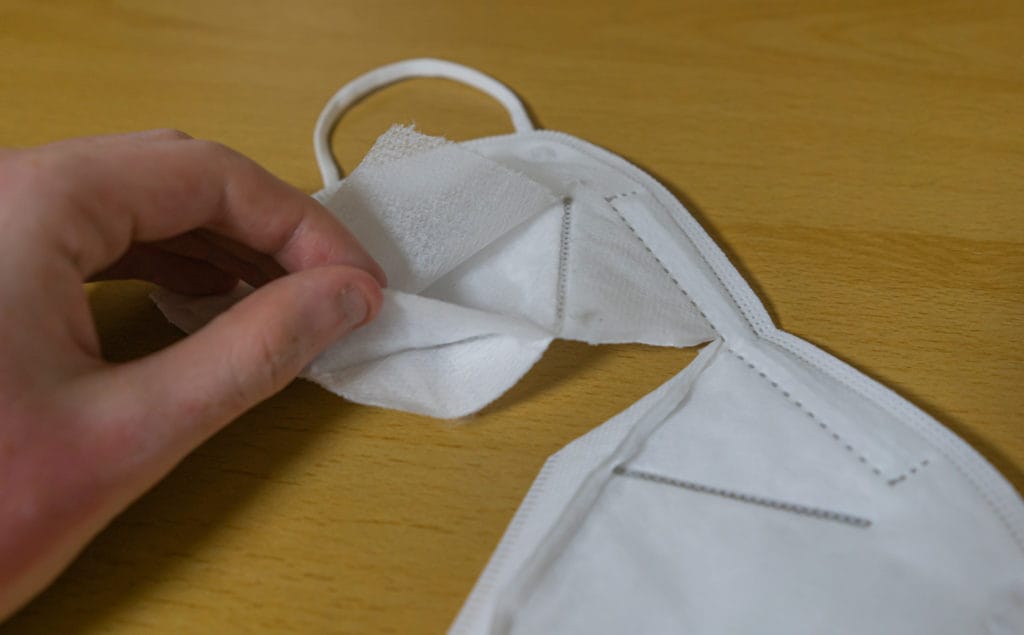
The filter layer of a KN95 mask.
Before we go further, I first want to clarify how filters work as this is vital for understanding the filtration mechanisms. I will be focusing on fibrous filters, which are those most often used in respirators. However, there are other filters such as activated carbon filters (for VOCs and other harmful gases).
Fibrous filters are made from thousands of small fibres that range vastly in size. Some can be under 1μm, while some can be as big as 100μm (3M). These fibres are randomly placed and create a web of fibres. Between these fibres are empty spaces, which is what allows us to breathe through the filter.
When particles enter the filter they don’t get caught in holes that are too small as many people believe. Rather, while trying to navigate the filter (which is largely open space), the particles contact fibres and get caught on them through the filtration mechanisms that I will explain soon.
Best N95 rated respirators – 3M 8511 N95 | 3M 8210 N95
Filtration Mechanisms
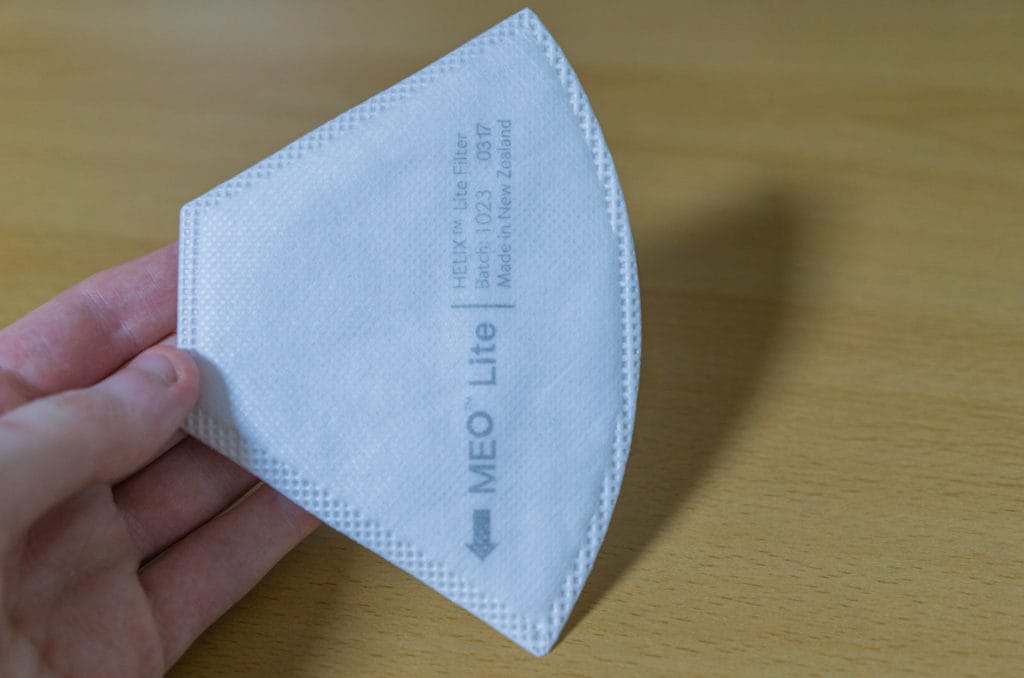
Replaceable P2 filter from MeoAir Lite.
The key to understanding the MPPS lies in understanding the filtration mechanisms that are found in the filters of respirators. While there are other mechanisms in play at times (such as electrostatic deposition), the most common mechanisms are gravitational settling, inertial impacting, interception and diffusion (TSI).
Each of these mechanisms captures particles that pass through the respirator in a different way. Further, they all impact different particle sizes in different ways. That is to say, some of these mechanisms (such as gravitational settling) are effective against large particles but have little or no impact on smaller particles.
This can also occur in reverse, where some mechanisms such as Brownian Diffusion impact only the smaller particles but have little or no impact on larger particles. Below is a list of the different types of filtration methods commonly found in fibrous filters.
- Gravitational Settling
- Inertial Impacting
- Interception
- Diffusion
- Electrostatic Deposition (attraction)

Gravitational Settling is caused by force exerted on particles causing them to follow the direction of the force. In this case, the force is gravity, forcing the particles down. These falling particles will come into contact with fibres in the filter and settle on them.
Inertial impacting is another mechanism that impacts particles passing through a filter. Within a filter, there is a path of least resistance and streamlines. Particles will attempt to follow these streamlines through the filter. However, due to inertia, the particles can not always follow the streamline and may get caught on fibres.
Interception is the third mechanism and occurs when a particle follows a streamline through the filter. However, the streamline passes too closely to a fibre, and the particle gets caught, preventing it from going further.
Diffusion (also named Brownian Diffusion) is the final filtration mechanism and this occurs on the smallest of particles. Due to the law of Brownian Motion, these particles will often wander from the streamlines. These particles will, in the vast majority of cases, impact a fibre within the filter while wandering.
Another mechanism which is used in some filters is that of electrostatic deposition. This method involves charging the fibres in the mask with a positive or negative charge so that they attract particles of the opposite type.
Mechanisms & Particle Size
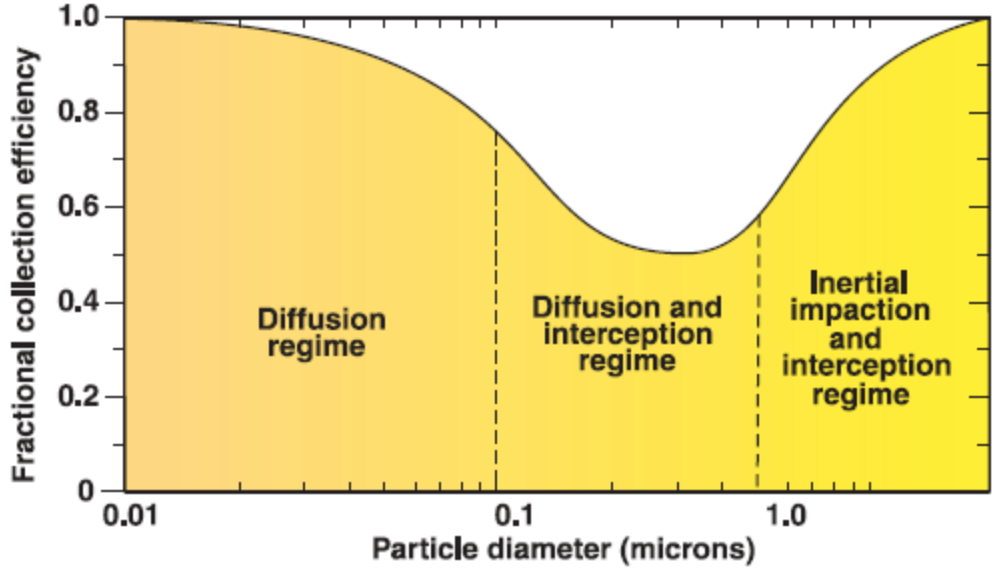
Now that we have briefly covered the basic mechanisms of filtration, it’s important to learn about how each of these methods impact different sized particles. Every mechanism has a different particle size-range that it is effective against.
Gravitational Settling – only impacts the biggest and slowest moving particles. The particles are usually over 1μm. The majority of particles, however, are too small to be impacted by this mechanism and for this reason, settling is often not considered as a filtration mechanism.
Inertial Impact – impacts mid-sized particles. While the exact size can vary, it usually impacts particles> 0.4μm – 0.6μm. This means that inertial impact becomes less effective against particles smaller than 0.4μm, and that is one of the reasons why the MPPS is 0.3μm.
Interception – impacts mid-sized particles. Similar to inertial impaction, interception has the greatest impact on particles > 0.4μm. Usually interception and inertial impaction occur in the same particle size-range, and they often work in conjunction of one another.
Diffusion – impacts only the smallest particles. Diffusion occurs when particles are < 0.1μm in diameter. Therefore, most respirators and filters actually have better filtration of smaller particles than particles around 0.3μm.
As you can see, there is a range between 0.1μm and 0.4μm where no mechanism is fully effective (TSI). While interception and diffusion do occur within this range, they are not as effective as they are for larger/smaller particles. This is why the MPPS occurs within this range.
Best N95 rated respirators – 3M 8511 N95 | 3M 8210 N95
MPPS – Most Penetrating Particle Size
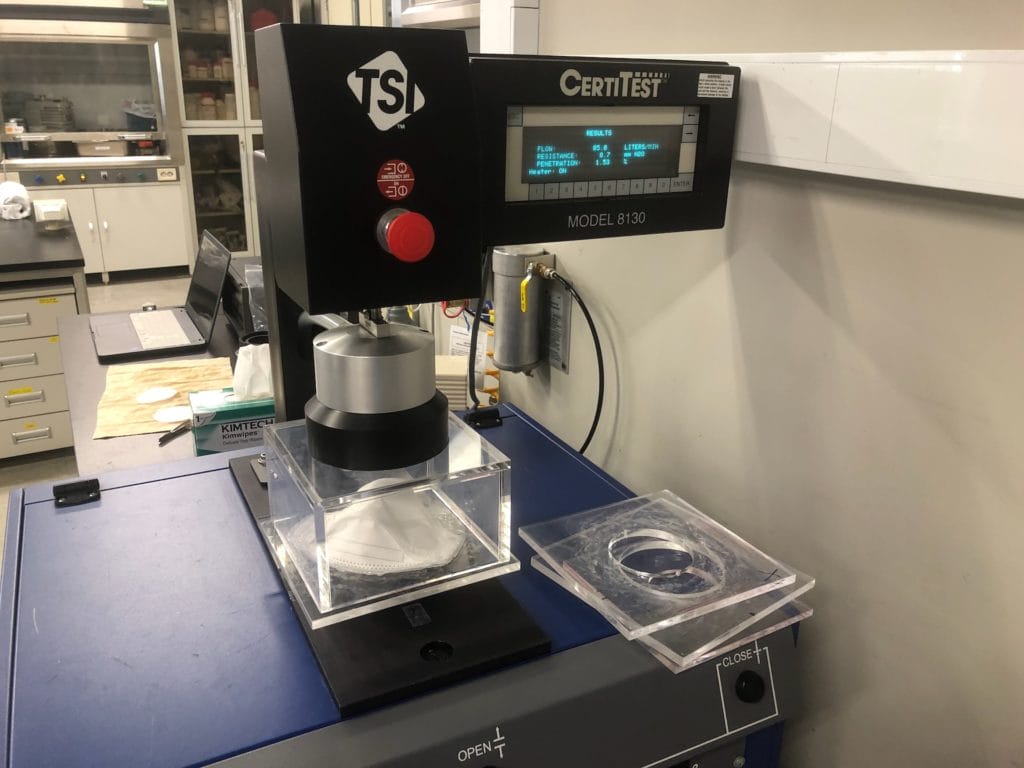
TSI 8130 Automated Filter Tester.
This brings us to the Most Penetrating Particle Size. As we can see with the different filtration mechanisms, each type impacts a different size of particle. There is almost always a dominant form of filtration mechanism in use.
However, there is a point in between these mechanisms where there is no dominant system. This point is between diffusion and interception, and where interception is more effective against larger particles and diffusion against smaller particles, in this range neither of them is totally effective and they operate in conjunction with each other.
It is in this range of particle sizes that the MPPS occurs. This is a phenomenon that occurs in all particle filters and it is why we test HEPA and respirator filters using a particle size of around 0.3μm.
While the MPPS can differ depending on filter specifications, it is an easy standard number to use. Usually, MPPS ranges from 0.05 to 0.5μm, and in respirators, it normally occurs around 0.3μm.
When respirators and other filters are tested using an MPPS, this is supposed to represent the filter operating at its worst case conditions. In reality, particle sizes will vary a lot more than they do in the MPPS tests used to certify filters, however, it is tested this way so that we can see how filters perform at their worst.
Air pollution & why you need to worry.
Respirator Filter Testing

While the MPPS is the worst case particle size for filters, there are also other conditions that must be considered as they can influence the filtration capabilities. Some of these factors are humidity, flow rate, and particle charge.
When respirators are tested for the NIOSH standard, not only is the particle size a ‘worst-case scenario’, but so are many of these factors. Humidity is set to 85% at 38 degrees celsius for 24 hours before testing, the flow rate is 85 L/min (a moderately high work rate) and the particles are charge-neutralized (NIOSH CDC).
These factors along with the MPPS create a situation in which the respirator or filter should perform at its worst. In theory, these are the worst (or close to) conditions under which the filter should be used.
Therefore, the filtration rating that we see for respirators and filters is actually lower than what you would realistically expect in real-world use (assuming a perfect seal of the respirator).
While these specific conditions change based on the respirator rating system, it shows how stringent the NIOSH system is for rating. Most other systems use the MPPS, however, some of the other factors can differ.
Conclusion
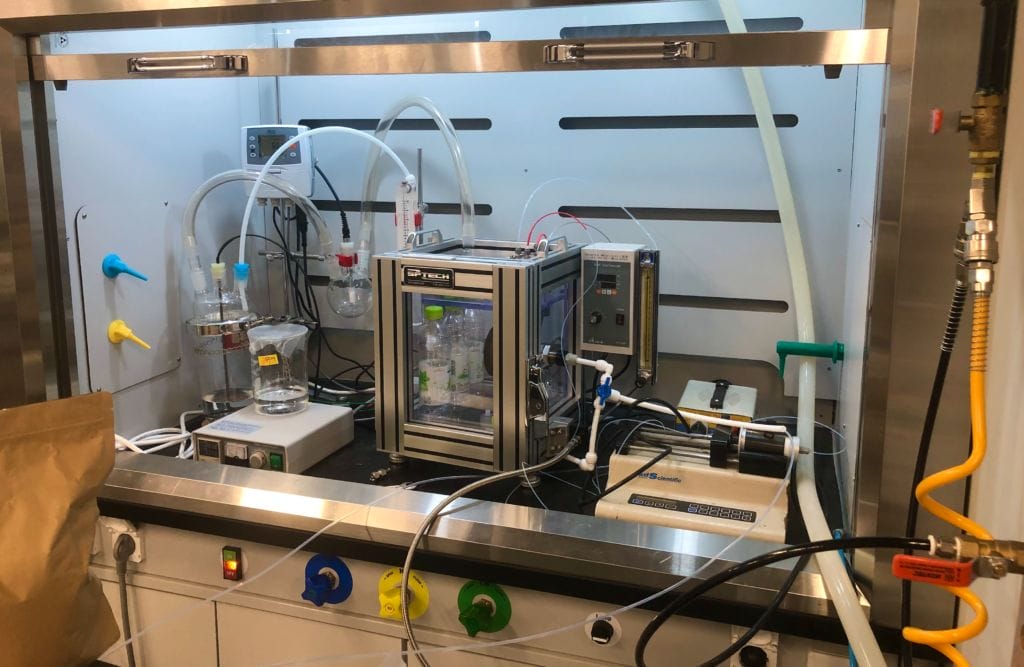
Chemical filtration testing.
Although it may not seem to make sense at first, there are many reasons why filtration efficiency drops in the middle of the particle size range. I hope that this post has helped to clarify how this happens and why.
Perhaps the most interesting takeaway here is that most respirator rating systems (especially NIOSH) actually use the MPPS in their tests. Therefore, the tests that these respirators undergo should show (within reason) their worst performance. However, even at their worst these respirators can achieve N95 or greater ratings.
If you have any further questions about filtration or related aspects, please feel free to contact me. You can do so by commenting on this post – I will reply as soon as I am able to!
FAQ
What Does MPPS Mean?
MPPS stands for ‘most penetrating particle size’. This refers to the particle size that has the highest rate of penetration through a filter.
What Size Is MPPS?
MPPS varies depending on filter variables (material, thickness, and many more factors). Usually, it sits between 0.05μm and 0.5μm.
How Big are Respirator Pores?
Pores on respirators can often be bigger than 50μm. However, it’s important to note that pore size is not the mechanism that captures particles. Rather, they are caught through diffusion, impaction, interception and settling.
Why Are Respirators Tested at 0.3μm?
Respirators are tested at 0.3μm because this is the MPPS for most filters. While the exact MPPS can range, it is usually close to 0.3μm, so that is the standard MPPS that is used.
Can Respirators Filter Particles Smaller than 0.3μm?
Yes. In fact, they are usually more effective against smaller particles. 0.3μm is the most penetrating particle size, and both bigger AND smaller particles are less penetrating. However, once you get to tiny particles (such as those in the tens of nano metres), filtration starts to decrease again.
Have Questions or Comments?
Join the discussion on the BreatheSafeAir Community Forum. Ask any questions you have about air quality or adjacent topics and get quick answers!
Very interesting read, So many complex comparisons, thanks Ethan.
Thank you, Sondra!
I am very happy to hear that you enjoyed reading the article – this one took quite a lot of research to complete!
Thanks. Fascinating.
Do you know how this relates to SARS-CoV2 specifically? On the face of it, the virus is pretty close to the optimal size to sneak through filters, as it is about 0.12 μm. However, that’s the bare virus and I imagine the virus isn’t usually floating in the air ‘naked’. It is in droplets of water/saliva/mucus, which are bigger.
For instance, the following paper says sneezes produce droplets of 100 μm, which filters should find much easier to take out. However, it says coughing produces droplets of around 1μm, which is still in the MPPS zone.
https://www.ncbi.nlm.nih.gov/pmc/articles/PMC7224694/
Hello Gareth,
Thank you for taking the time to read the article and comment!
I would need to do some more research before confidently commenting on the matter, but I would be happy to have a look and see what I can find. The points you raised are very interesting, so I will do some research and see if I can update this article/write a new one aimed at viral particle filtration.
Is there a typo with the following sentence from the article?:
“Therefore, most respirators and filters actually have better filtration of smaller particles that particles around 0.3μm (often called PM2.5).”
This seems to say that PM2.5 is particles of 0.3μm. I thought it meant particles of 2.5μm? So, nearly ten times bigger, and not so much in the MPPS zone. Correct me if I have misunderstood, but PM2.5 seems to be more relevant for pollution, but not viruses.
Thank you for pointing that out! That is indeed a typo. I will correct that right now.
Yes, PM2.5 is definitely more relevant for pollution. I didn’t want to discuss viral particles because I still don’t feel like I am informed enough on the matter. However, as I mentioned in my other comment, this is something I would be interested in writing more about once I do some more research!